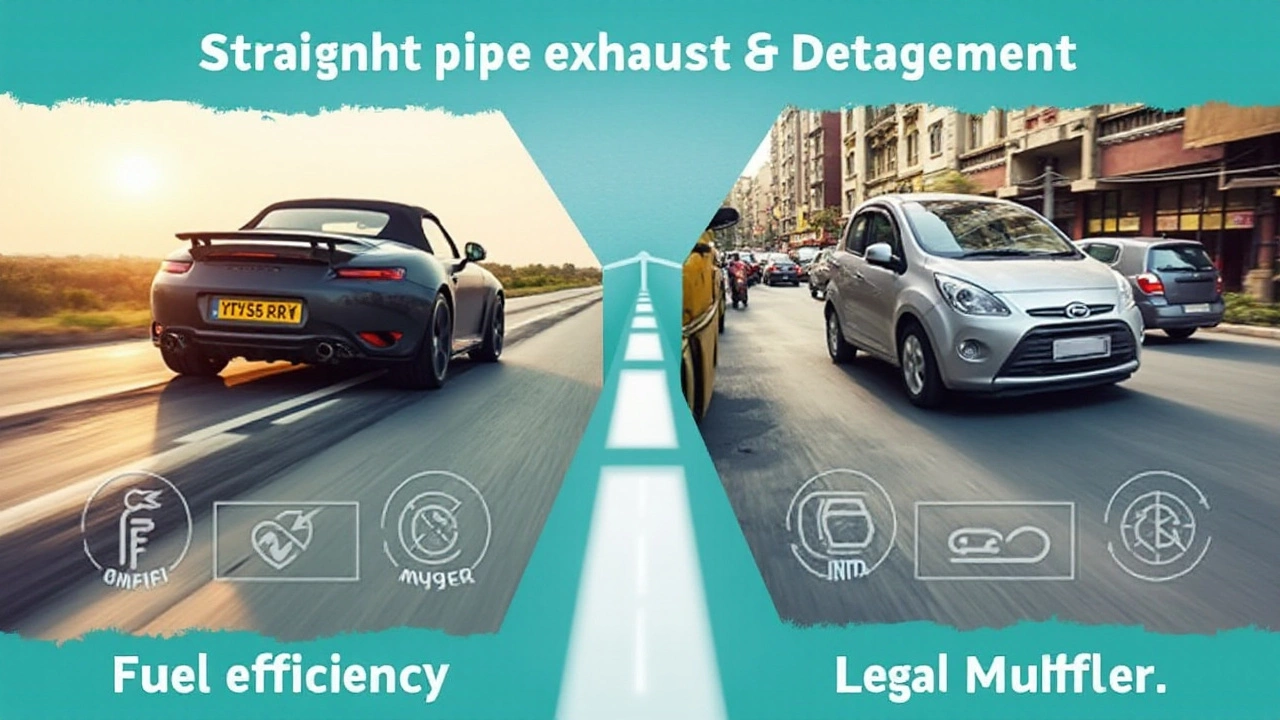 Jan, 29 2025
Jan, 29 2025
When it comes to choosing an exhaust system for your vehicle, many drivers face a common dilemma: straight pipe or muffler? This decision often boils down to personal preference, but it’s essential to know how each affects your car’s performance and noise level.
For those who value performance, a straight pipe system could be an attractive option. By eliminating any obstruction in the exhaust flow, straight pipes can potentially enhance horsepower and create a louder, more aggressive sound. However, this benefit comes with its share of downsides, such as increased noise pollution and potential lega issues in some areas.
On the other hand, mufflers are designed to dampen the sound of engine noise, providing a quieter and more comfortable ride. They can also help keep your vehicle compliant with local noise regulations, which is a significant factor for many car owners. While they may not offer the same performance boost as straight pipes, the comfort and legality might be well worth it.
To make the best choice for your vehicle, consider weighing these key differences, keeping in mind your driving style, local laws, and how much you value performance vs. comfort.
- Understanding Straight Pipes
- Benefits and Drawbacks of Mufflers
- Performance Considerations
- Legal and Environmental Impacts
Understanding Straight Pipes
The allure of straight pipe exhaust systems lies in their promise of unfiltered power and an unmistakable roar that turns heads. By design, a straight pipe removes any obstacles that could interfere with the exhaust gases escaping from the engine. Unlike conventional systems equipped with mufflers and catalytic converters, a straight pipe is exactly as its name suggests—straight from the exhaust manifold to the tip. This unencumbered flow can significantly reduce backpressure, which often translates to potential performance boosts in terms of horsepower and torque. Car enthusiasts often highlight how a straight pipe allows the engine to breathe freely, giving it a raw and more aggressive response. Such systems are commonly seen in motorsports, where every fraction of horsepower matters. According to a popular automotive editor, "A high-performance engine with a correctly tuned straight pipe exhaust can make a noticeable difference on the track."
However, the benefits of straight pipe systems come with certain trade-offs that warrant careful consideration. One of the most immediate effects is the dramatic increase in noise output. The artificial suppression of engine noise, usually achieved by mufflers, is eliminated. While this might be music to some enthusiasts' ears, it can become a significant nuisance, especially for everyday driving or long-distance travel. There is also the matter of emissions. Without a catalytic converter, which is bypassed in straight pipe setups, your vehicle will emit higher levels of pollutants, potentially making it unsuitable for street use in many regions due to strict emissions regulations. Always check local laws, as using a straight pipe on the road might lead to hefty fines. Furthermore, insurance rates may vary based on modifications, such as exhaust systems.
On a practical side, handling the installation of a straight pipe involves distinct technical challenges. It's not simply a matter of replacing one part with another; extensive tuning and adjustments are often required. The engine management system may need recalibrations to ensure optimal performance, which means that skilled personnel should perform the installation. There's also a cost consideration to factor in. While more affordable versions might be enticing, cutting corners could compromise the integrity and performance of your entire system. Additionally, increased vibrations and banging during everyday driving might affect other components over time, reducing the vehicle's longevity. Exhaust system choices like these need consideration beyond the immediate thrill they'll provide.
While there's a raw appeal to the straight pipe, its modifications are not always practical for daily drivers. Thus, weighing the benefits against the downsides—noise, legal concerns, environmental impact, and potential wear on the car—is essential. Car enthusiasts and racers might find straight pipes perfect for the track, but street drivers need to reflect on how these changes will align with their lifestyle and borders of acceptability. With that said, an informed decision will keep you on the right track—both in terms of performance and legality.

Benefits and Drawbacks of Mufflers
Mufflers serve an essential role in the exhaust system of modern vehicles. One of their primary functions is to reduce the noise produced by the car's engine. This ability to dampen sound is crucial for those who prefer a quieter driving experience or need to adhere to noise regulations in their region. Installing a muffler ensures that your car isn’t attracting unwanted attention for its roaring engine, which can be particularly beneficial for daily commutes in quiet neighborhoods or urban environments.
From a mechanical perspective, mufflers don’t just lower noise; they also facilitate smoother exhaust flow. By managing the way exhaust gases exit the engine, a well-designed muffler can improve backpressure balance. This balance often aids in maintaining engine efficiency, which, in turn, can subtly enhance fuel economy. While the boost in fuel efficiency isn't dramatically significant, every bit helps, given the rising fuel prices many of us face daily. However, it's important to recognize that not all mufflers are created equal. Choosing the wrong type of muffler could potentially compromise the performance gains you seek from your vehicle.
Drawbacks of Using Mufflers
On the downside, one of the significant concerns with mufflers is they might slightly restrict a vehicle's power. Because mufflers are designed to direct and dissipate sound waves, they can sometimes impede the free flow of exhaust gases. For performance enthusiasts, particularly those involved in competitive racing or high-performance hobby driving, this can be a notable disadvantage. While streetcars equipped with a muffler are more suited for daily driving than racetracks, it's crucial to weigh this trade-off when considering modifications.
An interesting fact that highlights their importance is that some regions impose fines on overly loud exhaust systems. Legally, a muffler can save you from potential penalties. According to the American Automobile Association (AAA), improper exhaust noise levels can lead to ticket costs upwards of $200, depending on state laws. This legal aspect prompts many to opt for muffler-inclusive systems, preferring to trade off a bit of engine noise for peace of mind on the legal front.
“It’s important to think about how loud exhaust sounds impact those around you. We always stress balance between performance and community respect,” says the National Hot Rod Association (NHRA) in their exhaust guidelines. This balance is where mufflers truly shine, offering a midpoint where performance doesn’t come at a cost to social responsibility.
Ultimately, deciding whether to include a muffler in your exhaust system is about defining your priorities. Are you more inclined toward achieving maximum horsepower, or is maintaining a moderately quiet driving experience your focus? Both those looking to avoid potential legal repercussions and individuals who appreciate a serene cabin atmosphere will find mufflers valuable. Meanwhile, performance-driven individuals might consider alternatives or modifications that navigate around these standard benefits and drawbacks, always ensuring their solutions remain compliant with local laws.

Performance Considerations
Choosing between a straight pipe and a muffler involves understanding how each affects your vehicle’s performance. Straight pipes are renowned for enhancing performance by reducing backpressure that naturally occurs in standard muffler systems. By allowing exhaust gases to flow more freely, a straight pipe can, on occasion, increase horsepower and torque. This setup is often preferred by racing enthusiasts and sports car owners who are looking to squeeze out every bit of power from their engines. On the flip side, drivers should consider that the removal of catalytic converters in these systems can impact emission levels, possibly limiting where the vehicle can be legally driven. Consequently, while you may obtain a sportier performance, achieving legal compliance in certain areas may become challenging.
Mufflers, designed to reduce noise, have a different impact on performance. Although they do introduce some backpressure, modern muffler technology often aims to strike a balance between noise reduction and maintaining reasonable performance. Contrary to popular belief, not all mufflers severely hamper vehicle efficiency; some high-performance mufflers are built to ameliorate flow issues and harmonize with the engine's natural dynamics. This is particularly advantageous for daily driving where comfort and legality override the need for maximum power. Moreover, incorporating a muffler doesn’t necessarily mean sacrificing performance. As Nathan Lee, a well-known automotive engineer, once stated,
“Today’s performance mufflers can retain much of an engine’s potential while ensuring a quieter, more comfortable ride.”For many vehicle owners, this balance sustains vehicle efficiency without the loud rumble that comes with extreme adjustments.
A deeper analysis of performance must also consider fuel efficiency. With a muffler, the controlled backpressure can theoretically enhance fuel economy by stabilizing engine output. While straight pipes may boost raw performance, they can sometimes lead to higher fuel consumption, especially if the system is tuned aggressively. This is an essential factor for those mindful of their ecological footprint or budget. Interestingly, some performance aficionados assert that careful tuning of a straight pipe can optimize consumption just as effectively, though it often requires professional oversight to achieve a harmonious balance between performance and efficiency.
To better understand the practical implications, take a look at the data comparisons of different exhaust setups and their influence on vehicle characteristics:
| Exhaust Type | Potential Horsepower Increase | Fuel Efficiency Impact | Noise Level (dB) |
|---|---|---|---|
| Straight Pipe | 5-10% | -5% | 95-105 |
| Performance Muffler | 2-5% | +2% | 75-85 |

Legal and Environmental Impacts
When deciding between a straight pipe system and a muffler, it is critical to consider the legal and environmental implications associated with each choice. Straight pipes, which are designed to increase the engine's power output, often forego muffling duties. This lack of sound dampening can lead to elevated noise levels, which may not only annoy neighbors but also run afoul of local noise ordinances. Many municipalities have specific regulations that limit the decibel levels a vehicle can produce, making it essential for car enthusiasts to familiarize themselves with these laws to avoid hefty fines.
The environmental impact is another vital consideration. While straight pipes might boost performance for some vehicles, they can also increase emissions. The absence of catalytic converters in certain straight pipe setups can result in higher levels of pollutants being released into the atmosphere. This can negatively affect the air quality, contributing to smog and health issues in urban areas. Environmental agencies are increasingly cracking down on such modifications, enforcing stricter emissions standards to protect the planet's health.
In contrast, a muffler system, typically equipped with a catalytic converter, plays a crucial role in reducing harmful emissions. Mufflers help maintain a balance between optimal performance and environmental conservation by limiting the amount of noxious gases expelled by the vehicle. Many states enforce stringent emissions testing, ensuring that vehicles adhere to the required environmental standards. Driving without a muffler might not only harm the environment but could also result in a failure to pass the necessary emissions checks required for vehicle registration.
Understanding the importance of these legal and environmental aspects helps you make an informed decision. A story from a friendly mechanic one might encounter at a car show illustrates this point well: he replaced the straight pipe on his beloved hot rod with a muffler system to meet city regulations. "I hadn’t realized how much it affected my carbon footprint until my daughter came home with a school assignment on environmental protection. It was an eye-opener," he shared with a smile.
Finally, it’s worth considering that the choice between a straight pipe and a muffler system is not just about personal preference. It carries implications for your relationships with your community and your commitment to environmental stewardship. If you're keen to slim down on your emissions, upholding these responsibilities can give you a good reason to lean towards a muffler system.